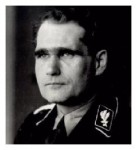
Rudolf Hess was one of Adolf Hitler’s longest-serving allies. Hess was born in Egypt in 1894, the son of a wealthy expatriate German businessman. He enlisted as an infantryman in World War I and served on both the Western and Eastern Fronts, where he won the Iron Cross for bravery. In 1918 Hess joined the German Air Corps, however, the war ended just a month after he qualified as a pilot. After the war, Hess enrolled in university but soon became swept up in the disorder and political conflict of the early 1920s. He joined a Freikorps unit and the Thule Society, a right-wing volkisch group popular with many early Nazis.
Hess first heard Hitler speak in mid-1920 and immediately joined the NSDAP. In 1923 he led an SA battalion during the Munich putsch, an act that led to his imprisonment alongside Hitler. The two bonded further during their time in Landsberg prison, during which Hess transcribed and edited Hitler’s memoir, Mein Kampf. When the Nazis gained power in 1933, Hess was named as Hitler’s ‘deputy Fuhrer‘ – though in real terms Herman Goering was the more likely successor. Still, Hess wielded considerable influence both within the party and in domestic policy. He was involved in party organisation and security, and contributed to the drafting of the Nuremberg Laws. In addition, Hess was often tasked preparing Hitler’s audiences prior to important speeches.
Hess’ importance and visibility diminished with the onset of World War II. Instead, he worked behind the scenes, running the Reich Chancellery and overseeing Hitler’s personal affairs and schedule. But Hess was also disillusioned by the progress of the war – especially plans for Operation Sealion, Hitler’s plan to bombard then invade Britain, a country Hess admired. In May 1941 Hess commandeered a plane and flew solo across the English Channel, parachuting into Scotland. There is considerable debate about why he did this. Some believe Hess wanted to broker an Anglo-German peace deal; others suggest he was mentally unwell – or even a British agent. Whatever the reason, Hess was immediately arrested, interrogated and detained. The Nuremberg war crimes trials of 1946 sentenced Hess to life imprisonment; he would spend more than four decades in custody at Spandau Prison, Berlin, before his suicide in 1987.
1. Rudolf Hess was a veteran of World War I who became a Freikorps trooper and foundation member of the NSDAP.
2. Hess played an important role in the 1923 Munich putsch and was subsequently imprisoned alongside Hitler.
3. In 1933 Hess was named as Hitler’s deputy Fuhrer, though in reality Goering was the logical successor.
4. Hess was in charge of the Chancellery, overseeing party organisation and Hitler’s personal schedule.
5. In 1941 Hess fled Germany for uncertain reasons, seizing a plane and flying to England, where he was arrested and detained. He was sentenced to life imprisonment at Nuremberg.
© Alpha History 2018. Content on this page may not be republished or distributed without permission. For more information please refer to our Terms of Use.
This page was written by Jennifer Llewellyn, Jim Southey and Steve Thompson. To reference this page, use the following citation:
J. Llewellyn et al, “Rudolf Hess”, Alpha History, accessed [today’s date], https://alphahistory.com/nazigermany/rudolf-hess/.

